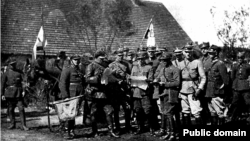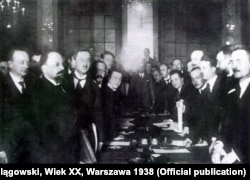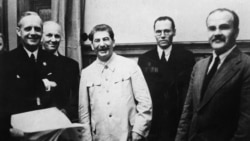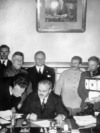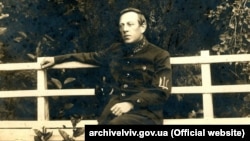One hundred years ago, a treaty now forgotten by many was signed in the Latvian capital, Riga. It formally ended an undeclared war between Poland, just reemerging on the map after being wiped out centuries earlier, and upstart Bolshevik Russia, which was preaching world communist revolution.
The Treaty of Riga redrew the borders of much of Eastern Europe, but for many it came to be seen as an unmitigated disaster -- in particular among Lithuanians, Belarusians, and Ukrainians whose hopes for democratic independent states were largely dashed as a result of the pact.
Instead of unified nations, Belarusians, Ukrainians, Lithuanians, and to an extent Poles found themselves split among competing states that at times viewed them with suspicion at best and hostility at worst, especially during Soviet dictator Josef Stalin's Great Terror in the 1930s.
For Bolshevik leader Vladimir Lenin, the stronger Soviet-styled republics that would emerge because of the treaty in Belarus and Ukraine would bolster his government, leading to the formal establishment of the Soviet Union in December 1922.
But outside of ending the conflict, the Treaty of Riga "satisfied nobody," explained Christoph Mick, professor of modern European history at the University of Warwick in the United Kingdom.
"It ended the Soviet-Polish war, but left territories with a Ukrainian and Belarusian majority in Poland. It undermined the plans of the Polish chief of state, Marshall Jozef Pilsudski, to create an intermarium federation [from the Baltic to Black seas] under Polish leadership in Eastern Europe or have at least a Ukrainian buffer state between Poland and Soviet Russia," Mick said in e-mailed comments to RFE/RL.
"It ended Soviet hopes to export the revolution to the West and later made the Soviet Union a revisionist power -- in its attempt to regain control of the lost Ukrainian and Belarusian lands," he added. At the same time, however, "Ukrainians were disappointed because Poland had abandoned them and by losing their chances of independent statehood."
The new order would prove ephemeral, in any case. In 1939, the Molotov-Ribbentrop Pact would include secret protocols enabling Stalin's Soviet Union and Adolf Hitler's Nazi Germany to divide Poland and the Baltic states and would lead quickly to World War II. After the war, the borders were shifted again -- but the Treaty of Riga would leave its legacy, sowing distrust in Eastern Europe, for example between Poles and Ukrainians, that are still evident today.
War After War
World War I left a wave of destruction across Europe, leaving 40 million soldiers and civilians dead or wounded. The German, Russian, Habsburg, and Ottoman empires all crumbled. New states emerged from their ashes, among them Poland.
Torn apart by Russia, Prussia, and the Habsburg empire in the 18th century, Poland reemerged on the map. The young reborn state, however, faced numerous challenges, including its unsettled borders on its eastern frontier with Russia.
Russia was thrown into civil war after the Bolshevik Revolution. Having withdrawn from the fighting of World War I, the country had no representation at the talks that resulted in the Treaty of Versailles, leaving issues impacting Russia -- like borders -- largely unresolved.
The vacuum sparked conflict between Soviet Russia and the new Polish state. Poland was eager to acquire more land it had held in the past, especially in what is now Ukraine. Lenin viewed Poland as the "Red Bridge" across which communist revolution would spread to Germany, the industrial country he believed best suited to embrace the doctrine.
Fighting flared in 1919-20. Troops from Poland and Ukraine marched into Kyiv in April 1919, before they were ultimately pushed back by the Red Army, which advanced as far as the gates of Warsaw. There, in August 1920 outnumbered Polish forces defeated them in what became known as the Miracle on the Vistula.
Peace talks opened in Minsk on August 17, 1920, shifting to Riga on September 21 amid a strong Polish counteroffensive. After months of negotiations, a treaty was signed in the Latvian capital on March 18, 1921. Here's how it affected peoples and countries in the region.
Poland
Its forces advancing, Poland was in a stronger position as talks opened. Bolshevik Russia had largely vanquished opposition White forces, but faced growing unrest, perhaps best illustrated by the Kronstadt rebellion. Lenin offered to cede lands captured by advancing Polish forces, including Minsk, but Polish negotiators balked. Why? The Polish negotiating team was led by Stanislaw Grabski, a leader of the National Democratic Party, which feared that non-Poles from the "kresy," or borderlands, would be an unfriendly voting bloc.
The Polish state that emerged from the Treaty of Riga included 27 million people and nearly 400,000 square kilometers, making it the sixth-largest in Europe. Poles left behind in Soviet territory would suffer. During the Great Terror, Stalin's secret police, the NKVD, rounded up more than 150,000 during its Polish Operation in 1937-38, 110,000 of whom were shot dead.
Lithuania
During the fighting between Polish and Soviet Russian forces, an independent Lithuania was already established that included Vilnius. But in October 1920, Polish troops moved in on the orders of Jozef Pilsudski, the Polish general and head of state, who yearned to resurrect the old Polish-Lithuanian Commonwealth, stretching from the Baltic to the Black Sea. In Vilnius, a city with large ethnic Polish as well as Jewish populations, "Central Lithuania" was declared, which was to be one canon in a planned Polish-led federation.
Lithuanian nationalists -- now based in Kaunas -- were opposed. To make that point clear, they formally renounced the 1569 Lublin Union that had enshrined the old Polish-Lithuanian Commonwealth centuries earlier. Minorities in Vilnius boycotted a 1922 referendum on whether it should be annexed to Poland. Losing Vilnius hobbled the new Lithuanian state and fueled ethnic-based nationalism, according to historian Timothy Snyder. "Whatever Pilsudski thought he was doing, taking the city by force of arms was bound to drive Lithuanian nationalists away from a political and toward an ethnic understanding of the nation," Snyder wrote in The Reconstruction Of Nations, Poland, Ukraine, Lithuania, Belarus, 1569-1999.
Ukraine
Ethnic Ukrainians, numbering some 10 million people, were spread across the lands controlled by Poland and Bolshevik Russia. After World War I, a Soviet-backed Ukrainian state emerged with its center in Kharkiv. In western parts of Ukraine, the Ukrainian People's Republic led by Symon Petliura emerged. Forces loyal to Petliura fought alongside the Poles during the Polish-Bolshevik Russian war, briefly taking control together of Kyiv in April 1920. The alliance dissolved, however, and at Riga, Ukrainian hopes of an independent state were dashed. Instead, it was divided between Poland and Soviet Russia, which had a delegation from the Soviet republic of Ukraine -- but not Belarus -- take part.
Angered by the agreement, which he felt was shortsighted and cynically political, Pilsudski, who was an observer at the talks, reportedly later apologized to Ukrainian officers for it. Out of this frustration arose in the Galician region of Poland the Organization of Ukrainian Nationalists (OUN), an extremist group bent on establishing a state along ethnic lines in which non-Ukrainians would not be welcomed -- including Poles and Jews, who were targeted in attacks by the OUN. "Interwar Poland included hundreds of communities, barely touched by the state, whose residents knew who was Polish and who was Ukrainian," Snyder wrote.
While Ukrainians under Polish rule experienced forced Polonization, their ethnic brethren in the Ukrainian Soviet republic initially experienced a brief cultural boom, with newspapers, books, and schools using the Ukrainian language appearing. This would all end under Stalin, culminating in the Holodomor, or Great Famine, that left millions of Ukrainians dead.
Belarus
By the time the treaty was signed, the short-lived Byelorussian National Republic of 1918 was just a memory, crushed by the Bolsheviks. Any hope that a free, unified Belarus could emerge from the Treaty of Riga, would prove illusory. Like the Ukrainians, Belarusians found themselves torn apart. The Treaty of Riga left the Belarusian-speaking minority in Poland, "small and rural, as the National Democrats intended," Snyder noted. And without Minsk, the Belarusian intelligentsia was too small to serve as any ally for any Polish political formation, Snyder explained, adding that "once Minsk became Soviet, Belarusian national aspirations within Poland were seen as crypto-Bolshevism."
Like in Ukraine, Belarusians inside Poland faced forced Polonization, while Belarusians inside the Soviet republic enjoyed a brief cultural rebirth, including the establishment of Belarusian-language schools and an Institute of Belarusian Culture. However, under Stalin these policies were reversed with a vengeance. In the 1930s, up to 60 percent of the native Belarusian intelligentsia was killed in Stalin's purges. Mass murders were carried out in the Kuropaty Forest near Minsk between 1937 and 1941. Those crimes have never been fully investigated by Belarus, which under Alyaksandr Lukashenka has championed the Soviet past.




